Volume control is a critical aspect of a musician’s dynamic expression, and for guitarists, a volume pedal can be as essential as the guitar itself. It allows players to adjust their output level in real time, offering a way to create ambient swells, mute their sound tactfully, or fine-tune their volume without taking their hands off the guitar. The best guitar volume pedals provide a smooth taper, durable construction, and reliable performance, becoming a staple on pedalboards of both amateur and professional musicians. Here’s 8 of the best guitar volume pedal options across a wide range of price points to suit your needs.
Much like picking the right guitar, choosing a volume pedal that complements one’s playing style is crucial. Some volume pedals come with additional features like tuner outputs or active electronics, while others keep it simple with passive designs. The construction material, the potentiometer resistance, and the pedal’s sweep range are a few of the attributes that can affect a pedal’s performance and durability.
When shopping for a guitar volume pedal, it’s important to consider the pedal’s compatibility with other equipment, the precision of volume control, and the physical footprint on a pedalboard. The taper of the pedal—how the volume changes as the pedal moves—also has a significant impact on its responsiveness and suitability for a player’s needs. We’ve put numerous volume pedals through their paces to determine which models offer the best combination of build quality, control precision, and functional versatility.
Having scrutinized a collection of volume pedals on the market, we’re here to guide guitarists through the nuances of selecting a premium tool that can enhance their sound and performance. Our thorough evaluation aims not just to isolate the top choices, but also to equip players with the knowledge to find a volume pedal that feels like a natural extension of their musical expression.
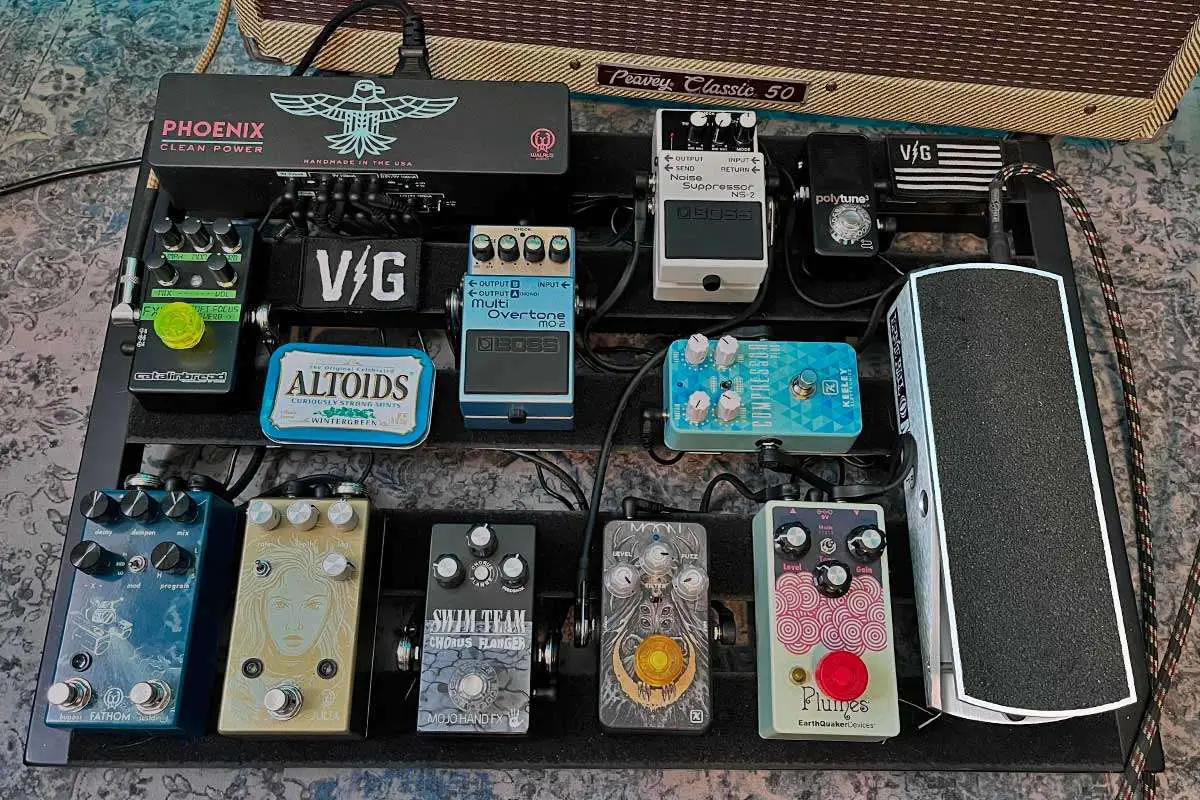
Top Guitar Volume Pedals
We’ve meticulously tested and reviewed a wide array of guitar volume pedals to bring you our selection of the best options available. In this meticulously curated list, we focus on durability, ease of use, and the quality of volume control they offer, ensuring that whether you’re using it in the studio or on stage, you’ll find a pedal that fits your needs perfectly.
Ernie Ball MVP
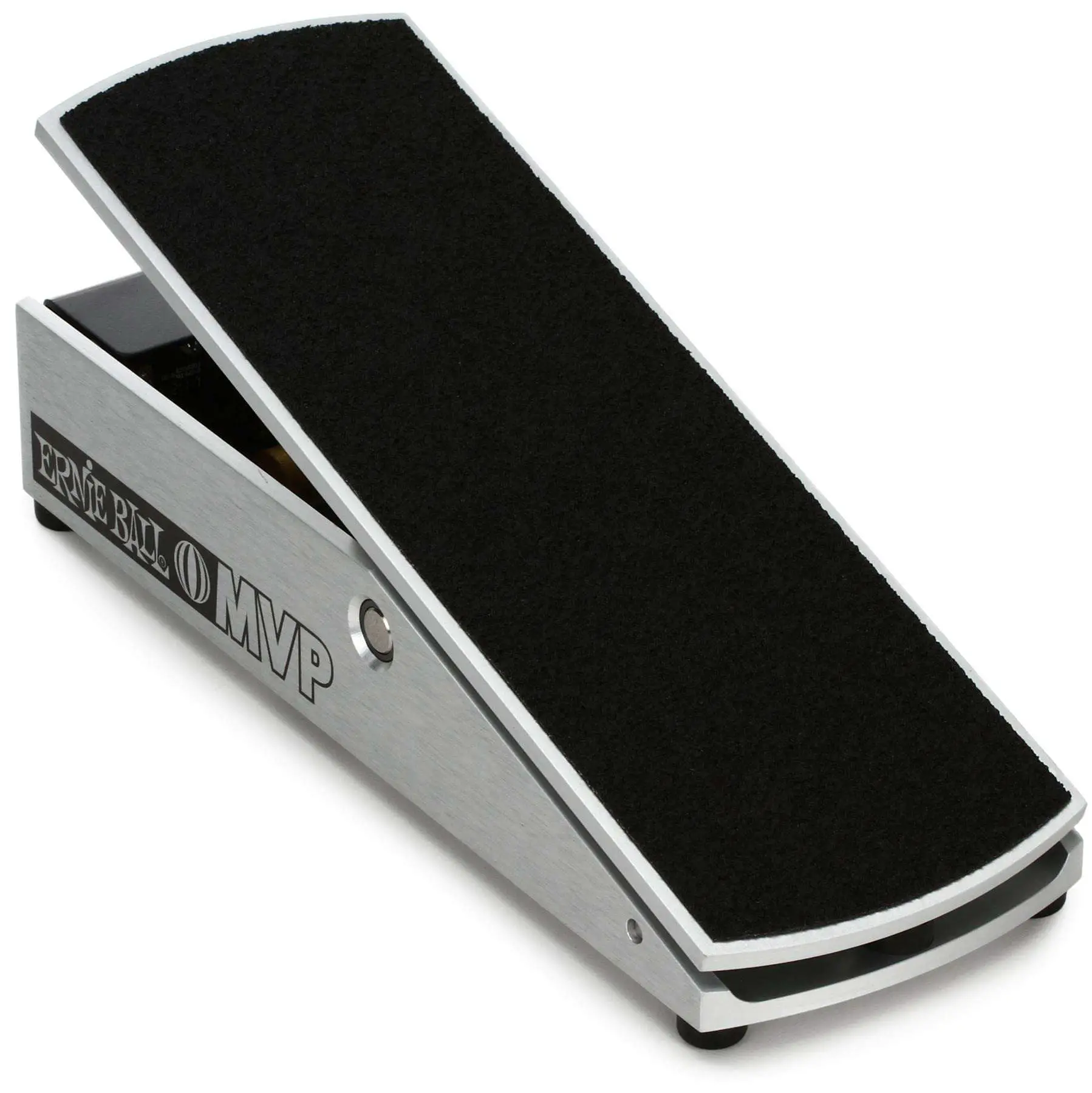
We found this pedal to be a robust tool for any guitarist aiming to control their volume with precision without sacrificing tone quality.
Pros
- Tailorable minimum volume and gain boost settings
- Durable aircraft-grade aluminum housing
- Seamless compatibility with active and passive pickups
Cons
- Might be too sturdy for those who prefer lightweight pedals
- Some units may have quality control issues
- Power supply or battery needed, not included
As frequent performers and session players, we understand the necessity of having a reliable volume pedal. The first time we took the Ernie Ball MVP on stage, its super smooth foot sweep for precise volume control was instantly noticeable. Craftsmanship feels top-notch, and we’re confident it can withstand the wear and tear of regular gigs.
Its minimum volume control feature was a game-changer during one of our recent gigs, allowing us to keep the ambient sounds while we tuned or chatted with the audience. And when it was time to launch into a solo, the gain boost added that extra punch without fumbling with the amp or other pedals.
With both active and passive pickups in our lineup, it’s a relief not to worry about compatibility issues. The MVP worked seamlessly, clearing up a spot on our pedalboard for other gear. However, when we initially set up the pedal, having to source our power supply was a momentary hiccup.
Overall, the MVP by Ernie Ball has secured a permanent place in our performance kit. It’s built like a tank, and the level of control it offers is a significant advantage, whether you’re playing live or layering tracks in the studio.
Dunlop Volume X Mini
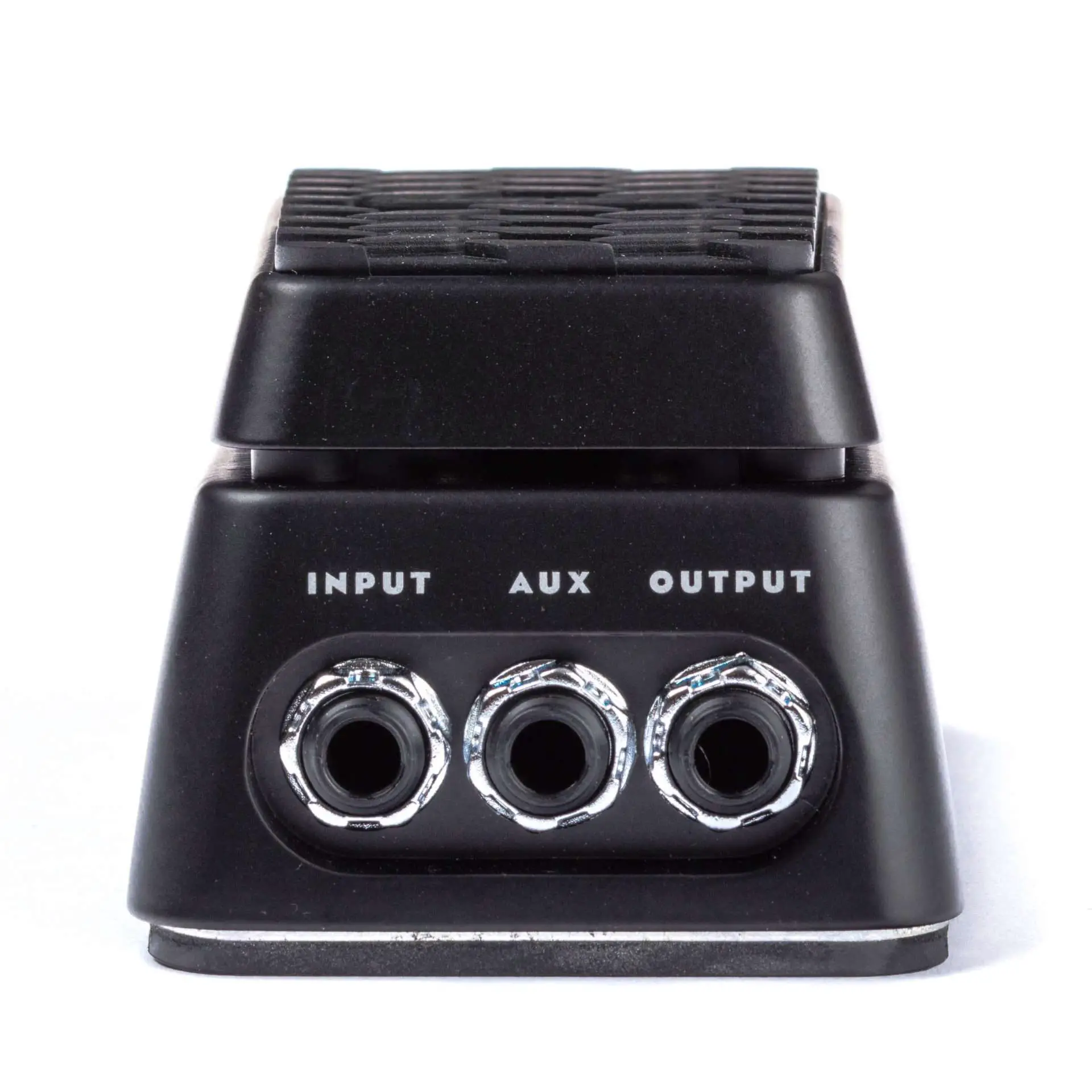
We think it’s a game-changer for pedalboard real estate without compromising on quality or control.
Pros
- Space-efficient design, perfect for crowded pedalboards
- Adjustable tension for personalized pedal feel
- Dual functionality as a volume and expression pedal
Cons
- The sweep might be too abrupt for those used to larger pedals
- Learning curve to master smooth swells
- Requires flat pedalboard surface for best performance
Immediately upon setting up the Dunlop Volume X Mini, we noticed its solid construction and the reasonable heft for its size, which instills confidence. Its compactness is a boon for our crowded pedalboard, allowing us to fit other effects without hassle. The aluminum chassis and non-slip tread exude a feel of durability and ensure the pedal stays put during use.
The level of customization impressed us too. The ability to adjust the pedal’s tension is a thoughtful feature – it allows us to fine-tune the pedal’s resistance to our liking. Whether we want a stiff response for precise volume adjustments or a looser feel for smooth swells, the Volume X Mini accommodates.
Using the pedal as an expression controller adds versatility to our setup as well. When we toggle the AUX output, integrating it with our tuner and effects feels intuitive and streamlines our rig even further. However, it took a few tries to get used to its response curve when performing volume swells, which felt different from the larger pedals we’re accustomed to.
Lastly, the minimalist design might slightly impact performance for users who prefer a larger pedal. The sweep can feel abrupt at first. Nevertheless, with some practice, we were able to achieve the dynamic control we needed. We recommend ensuring your pedalboard is on a flat surface to maximize the effectiveness and stability of the Volume X Mini.
Boss FV-500H Volume Pedal
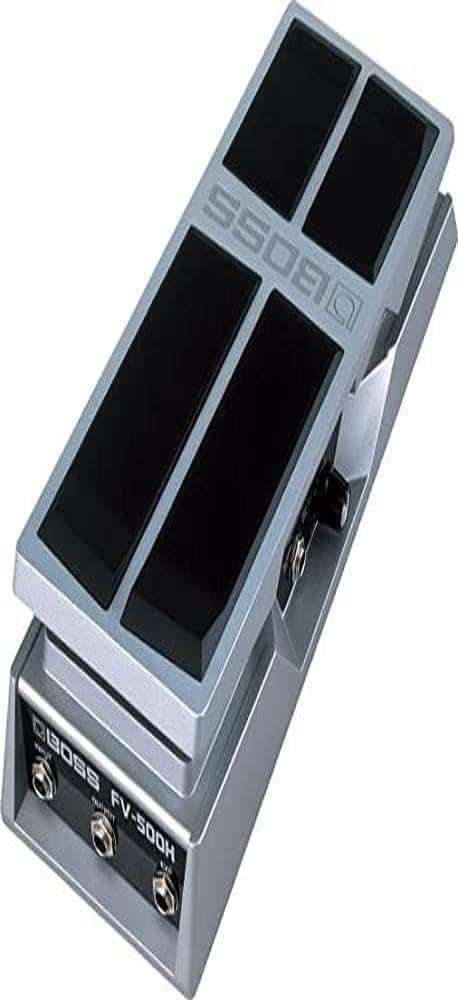
We believe the Boss FV-500H is a robust choice for guitarists seeking reliability and nuanced control in a volume pedal.
Pros
- Exceptionally durable with its heavy-duty aluminum construction
- Provides smooth volume control with customizable tension
- Versatile with expression pedal functionality
Cons
- Its weight makes it less portable
- May be too large for crowded pedalboards
- No power supply necessary, but some might prefer active electronics
Upon our first use of the FV-500H, we were impressed by the sturdiness of its design. The aluminum die-casting body exudes a ruggedness that assures us this pedal can withstand the rigors of heavy touring. The torque of the pedal can be adjusted, which allowed us to dial in the exact resistance we prefer, making volume swells precise and predictable.
Not just a volume controller, its ability to function as an expression pedal came in handy during performances, giving us more creative control over our sound. Additionally, the lack of the need for batteries or power is a freeing feature. We can simply plug in and play without worrying about power sources or signal degradation through active electronics.
However, the FV-500H’s considerable heft, while contributing to stability, might be a drawback for those of us who often play on different stages and value a lightweight rig. Also, its size can be a conundrum when you’re working with a limited pedalboard space. Some users might miss the availability of active electronics for buffering or impedance matching, but in our experience, this was not a detriment to the pedal’s performance.
In conclusion, we find the Boss FV-500H to be a workhorse in the realm of volume pedals. Whether it’s used in the studio or on stage, it offers an excellent balance between build quality and functional versatility. It’s clearly designed for serious guitarists who value durability and reliable performance.
Hotone Soul Press II

We think the Hotone Soul Press II is a solid choice for guitarists due to its versatility and crisp sound quality.
Pros
- Multi-functional with volume, wah, and expression options
- Compact size is a boon for cluttered pedalboards
- True bypass design maintains pristine signal integrity
Cons
- The footswitch can be stiff for some users
- Lacks the heft some guitarists prefer for a volume pedal
- Power supply not included, which could be inconvenient
As soon as we laid hands on the Hotone Soul Press II, the compact size made a strong impression. It’s evident right out of the gate that this space-saver doesn’t skimp on functionality. With the ability to switch between volume, wah, and expression modes, it becomes an indispensable part of our pedalboard. The mere flick of a footswitch initiates precise control over volume dynamics or injects the quintessential wah character into our music.
The sound quality deserves a shout-out – it’s clean and transparent when operating in volume mode, and the wah tones range from classic to warm, enriching our solos with a depth that other pedals sometimes miss. The built-in LEDs are handy for quick, on-stage checks of the pedal’s status, which means we spend less time fumbling and more time playing.
While the Hotone Soul Press II feels sturdy, it’s worth mentioning that it might take a little getting used to for those of us acclimated to more resistant pedals. Its lightweight nature is perfect for the traveling guitarist, but some may prefer the grounded feel of heavier pedals. Also, since it doesn’t come with a power supply, you’ll need to sort that out separately – a minor hassle but one to be aware of nonetheless.
In short, Hotone has crafted a multifunction pedal that may just become a new favorite for guitarists who value versatility and pedalboard real estate. Despite a couple of drawbacks, it stands out as a valuable tool for those looking to enhance their rig without compromising on sound or space.
Ernie Ball VP Jr 250K

If you’re considering a reliable and compact volume pedal, the Ernie Ball VP Jr 250K is your go-to for a no-fuss, durable performance enhancer.
Pros
- Impressive build quality with a strong, aluminum housing
- Conveniently compact, saving precious pedalboard real estate
- Offers a smooth volume transition with customizable swell rates
Cons
- Not suitable for active pickups due to 250k ohm resistance
- Might be too small for players with larger feet
- Absence of LED indicators which some users may miss
Our experience with the Ernie Ball VP Jr 250K has left us with little doubt about its utility and ruggedness. The moment we put it on our pedalboard, its sturdiness was apparent. Crafted from aircraft-grade aluminum, this pedal can withstand the rigors of the road and the enthusiasm of frequent use. Its smaller footprint allows it to snugly fit alongside other pedals without compromising on performance.
The transition between volumes is as smooth as silk – no abrupt jumps or losses in tone. Whether we aimed for subtle crescendos or more punctuated swells, the dual taper switch at the rear came in extremely handy. A quick flick gives a dramatically different response, making it easy to adapt to various musical contexts.
We’ve also particularly enjoyed the silent tuning feature. With a tuner output that cuts the signal when the pedal is heel-down, it’s refreshingly simple to tune up mid-gig without any extraneous noise. As seasoned musicians, we appreciate this thoughtful design – it makes a noticeable difference in live performance scenarios.
In summary, the Ernie Ball VP Jr 250K is robust, versatile, and a space-saver – a superb addition to our gear arsenal. It may not have the bells and whistles of more elaborate models, but what it does, it does excellently.
SONICAKE VolWah
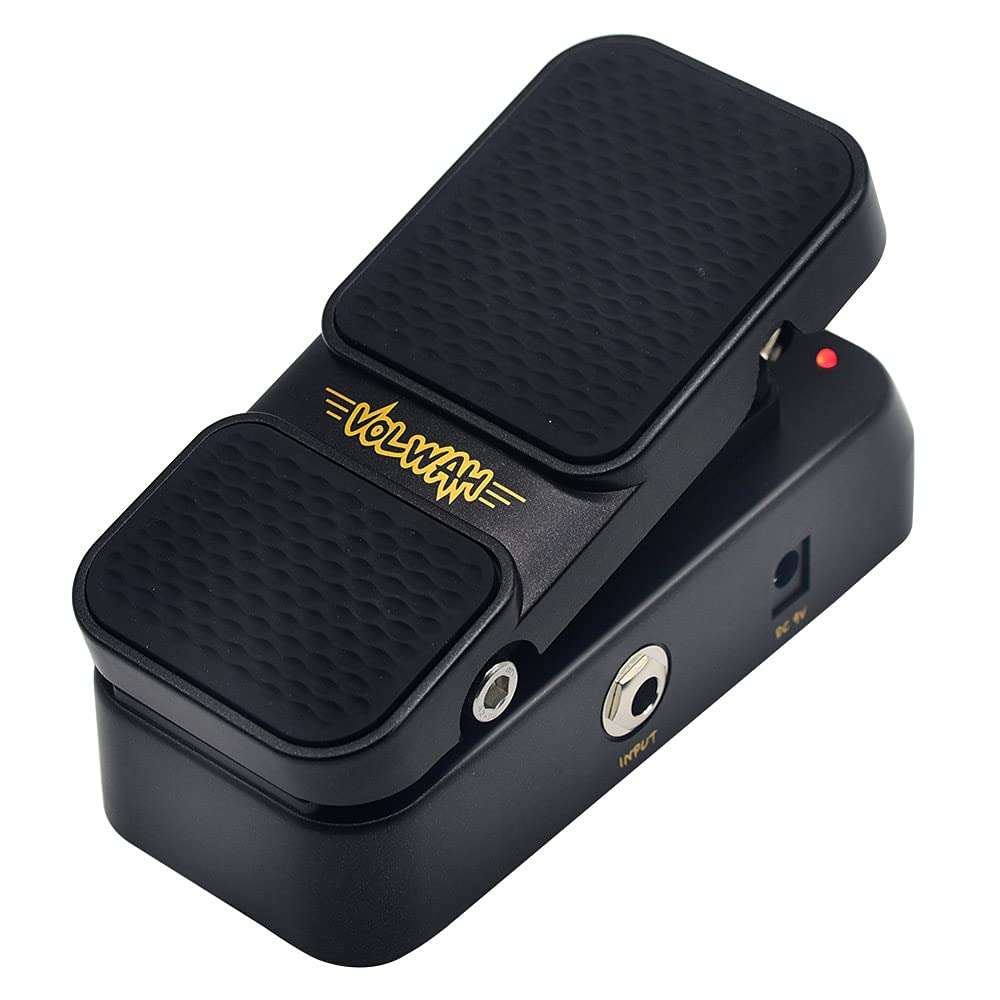
We found the SONICAKE VolWah to be an innovative space-saver on our pedalboard, offering both volume and wah functionalities that cater well to limited setups.
Pros
- Compact design fits well on crowded pedalboards
- Switchable between volume and wah, adding versatility
- LED indicators are handy for identifying the active mode on a dark stage
Cons
- The volume sweep might feel limited for those used to larger pedals
- Wah sound may not satisfy all tastes, especially compared to dedicated wah pedals
- Does not include a power adapter, requiring an additional purchase
After spending some quality time with the SONICAKE VolWah, we appreciate how it doesn’t compromise on the build quality despite its diminutive size. The pedal’s active volume control efficiently prevents any impedance mismatch problems, ensuring a clean signal flow. The vintage wah sound it produces has a distinct character; while not as nuanced as some full-sized wah pedals, it provides a satisfying expressiveness for most situations.
Switching between the volume and wah effects is seamless thanks to the cleverly integrated footswitch. We found the two-mode operation to be intuitive, even when engaging it mid-performance. The dual LED lights serve as a clear visual cue even on dimly lit stages, so we always know which function we’re using.
Despite its positives, the VolWah does present some limitations. Players accustomed to the expansive sweep of a larger volume pedal may feel slightly restricted. Additionally, the lack of a power adapter means you’ll have to source one separately, which can be a bit of an inconvenience.
To sum it up, the SONICAKE VolWah holds its own as a multipurpose pedal. It’s robust, reliable, and perfect for guitarists looking to save space without sacrificing functionality. Whether on a tight pedalboard or as part of a more extensive rig, it punches above its weight.
Donner Viper Volume Pedal

We believe the Donner Viper Volume Pedal is a versatile choice for musicians who value a compact design and dual functionality without the need for additional power.
Pros
- Seamless automatic switching between volume and expression modes
- Lightweight and durable construction for gigging musicians
- Does not require external power, simplifying setup
Cons
- Made of plastic which may not suit all durability expectations
- Lacks a battery compartment, limiting some usage scenarios
- Compact size might be too small for those accustomed to larger pedals
Navigating the dynamic landscape of live performance has been streamlined by the Viper’s intuitive design. The pedal’s capacity to intuitively alternate between volume and expression functionality responds effectively to nuanced foot control, demonstrating its adaptability across various musical genres. From a personal handling perspective, the sweep feels consistent and the action of the pedal has a good tension balance—not too stiff nor too loose—making it easy to dial in the precise level of expression or volume required.
Our experience with the Viper’s construction left us impressed by its sturdiness, despite being made from plastic. The lightweight nature proves to be a boon on stage, where quick setup and teardown are vital, and every ounce matters when transporting gear. Still, this pedal has weathered the hustle and bustle of gigs without showing significant wear, suggesting longevity in line with what gigging musicians need.
Practicality shines in the pedal’s design, which respects the musician’s space by maintaining a small footprint. While some may find the reduced size challenging if they’re used to more ample pedals, it fits comfortably on crowded pedalboards. We’ve come to appreciate this during packed gigs where every inch of stage space counts. Furthermore, not requiring a power supply or batteries, we’ve relished the convenience of plugging in and playing without scrambling for power outlets or fresh batteries.
SONICAKE Vexpress
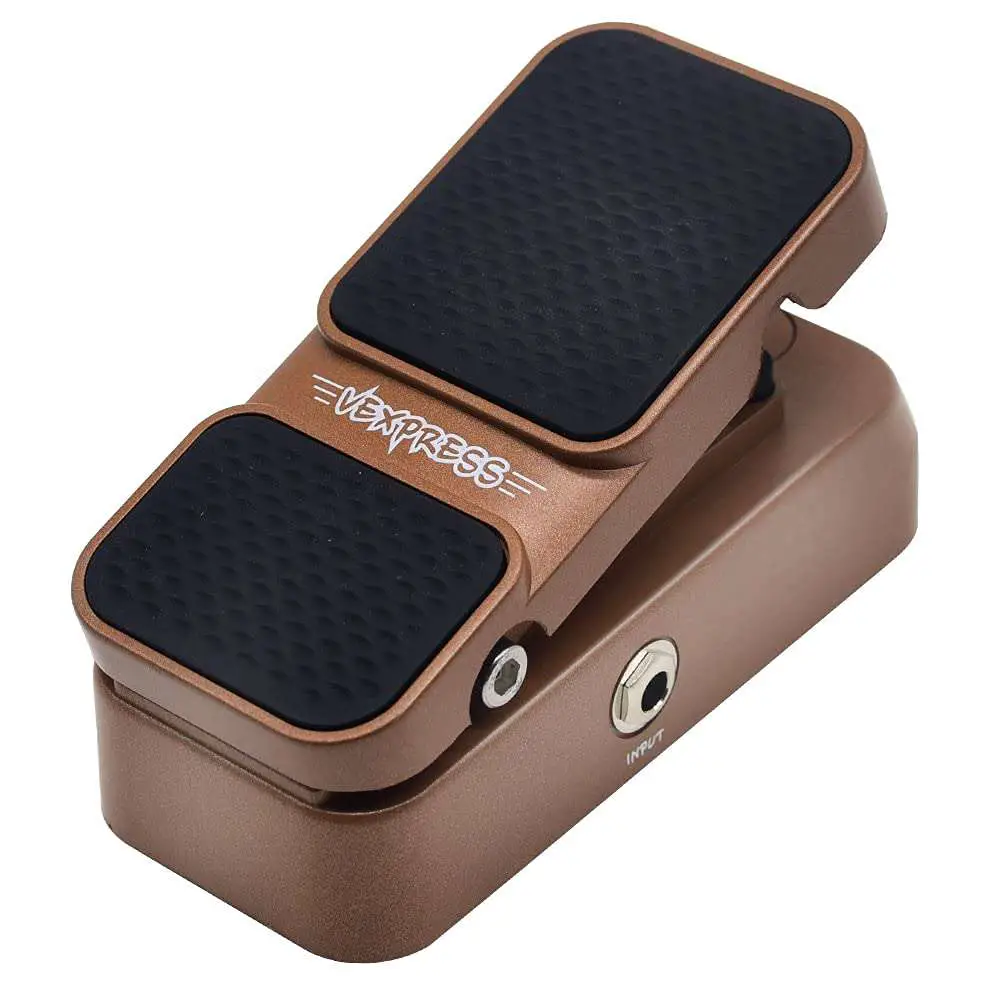
After giving the SONICAKE Vexpress a thorough workout, we think its versatility makes it a solid choice for musicians who need a compact solution without sacrificing functionality.
Pros
- Dual-function as both volume and expression pedal offers excellent utility.
- No need for batteries simplifies setup and use.
- Small footprint is perfect for pedalboards limited in space.
Cons
- Smaller size may be less comfortable for those with larger feet.
- Plastic construction might not endure heavy-duty use as well as metal.
- Lack of power might limit functionality for some users.
We have found the Vexpress to be remarkably intuitive – it automatically distinguishes whether we’re looking for volume control or expression, which streamlines our pedalboard interaction significantly. Being able to swap between these functions seamlessly has been a game-changer in both our studio sessions and live performances, especially when space is at a premium.
In our hands-on experience, the passive operation of this pedal meant we could just plug in and play without worrying about battery levels or locating a power outlet. This ease of use was a breath of fresh air, as it allowed us to focus more on our performance and less on gear management.
Despite its size, the Vexpress didn’t feel out of place beneath our feet. The compactness has its advantages, making it an easy addition without having to rearrange our existing setup. However, musicians with larger footwear might find the size a bit restricting, and while its lightweight design adds to the portability, we sometimes questioned its durability under rigorous touring conditions.
The plug-and-play aspect of the Vexpress won us over. It meant we could integrate it into our rig without fuss. The truth is, this pedal kept up with every twist and turn we threw at it, whether we used it to soften our keyboard’s volume or add nuanced expression to our guitar solos.
Though it might not be the sturdiest on the market, the SONICAKE Vexpress brings more than enough to the table for most situations. Its functionality, combined with its ease of use, makes it a contender for any musician keen on keeping their pedalboard light and their options open.
Buying Guide
When we’re in the market for a guitar volume pedal, there are several features to consider that ensure we get the best product for our needs. Let’s focus on the key aspects that demand our attention.
Durability
Firstly, a robust design is vital. A good volume pedal should withstand regular use and the rigours of transportation. We look for a solid construction, often metal, to handle the stress of frequent foot action.
Potentiometer vs. Optical
Potentiometer-Based Pedals
These pedals use a physical potentiometer that can wear out over time but offer a familiar response that many guitarists prefer.
| Pros | Cons |
|---|---|
| + Classic feel | – May wear out |
| + Precise control | – Requires maintenance |
Optical Pedals
Optical pedals don’t have physical parts that degrade, making them quieter and potentially more durable.
| Pros | Cons |
|---|---|
| + Less maintenance | – Different feel |
| + Quiet operation | – Can be pricier |
Impedance
We need to take note of the impedance, which should match our setup for optimal sound quality. Generally, high-impedance pedals work best with guitars directly into the pedal, while low-impedance pedals are suited for effects loops or keyboards.
Size and Footprint
We must consider the size and the footprint of the pedal, especially if pedalboard real estate is at a premium. A compact pedal might be necessary for us if space is limited.
Taper
The taper of the pedal affects how the volume changes as we use it. A gradual, smooth taper is often preferred for consistent and predictable volume adjustments.
Features
Finally, extra features can enhance the pedal’s versatility. For example:
- Tuner Out: Useful for silent tuning on stage.
- Minimum Volume Control: Allows us to set a minimum volume when the pedal is in the heel-down position.
- Stereo Operation: Necessary if we wish to control volume on two channels simultaneously.
By carefully considering these factors, we can select a volume pedal that meets our performance and durability needs.
